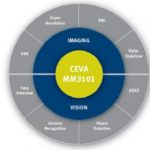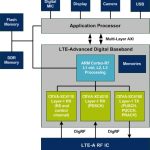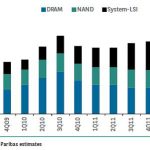The multiplication of chips capable to run Multimedia processing (sound, image or video) in a mobile device, smartphone or media tablet, like Application Processor (AP), Baseband (BB), Codec or companion chip, each of these embedding one or multiple processor can be seen as a good opportunity to simplify the device architecture…… Read More
Tag: ceva
MUST: DSP ready solution for tomorrow smartphone based on CEVA-XC 4000
Like Guiness dark beer, competition is good for you! I mean good for end user, as it pushes DSP IP supplier to provide ever better solution. I am not talking about me-to type of competition, like that we have seen in the past with IBM trying to displace TI at Nokia, by offering a LEAD (DSP IP core from TI used in every NOKIA wireless phone… Read More
Welcome to the Video Club!
CEVA is happy to welcome new competitor in the DSP IP solution for Computer Vision and Imaging elitist club! In fact, we all know that the competition is not only good for IP customers, but is also a good way to boost innovation and propose continuously improved solutions, and Computer Vision and Imaging is one field of high creativity,… Read More
Audio/Voice DSP IP core: the next road to billion unit shipment
When mentioning CEVA DSP IP cores, the first reaction is to think about the complexes DSP functions used into wireless Modem Application like 3G and Long Term Evolution (LTE). Considering that CEVA market share is above 70% for these products, such a reaction makes sense. But did you knew that CEVA DSP IP cores are also empowering… Read More
When ARM and CEVA team-up for “Designing a Multi-core LTE-A Modem”
ARM and CEVA have launched a white paper, addressing one of the hottest topics of the day: LTE-Advanced modem architecture. This very exhaustive paper, written by David Maidment (Mobile Segment Manager, ARM), Chris Turner (Senior Product Manager, ARM) and Eyal Bergman (VP Product Marketing, Baseband & Connectivity, CEVA… Read More
CEVA also bid to acquire MIPS… ARM still staying quiet?
We have seen in a previous post that Imagination Technologies has proposed to buy MIPS, in fact “MIPS operating business and certain patent properties, as well as license rights to all of the remaining patent properties”. Translated into understandable language Imagination has offered $60M for MIPS Processor IP core portfolio,… Read More
4 Billion CEVA powered Chips shipped
Why making the difference between chips and cores, when mentioning that CEVA’s customers have shipped four billion IC to date? Because that can make a big difference! Imagine for example an IP vendor selling processor IP cores to be used in massively parallel computing application, when the chip maker create a processor NxM matrix,… Read More
Samsung going vertical Qualcomm cry CEVA laugh
These last days have been full of Apple related stories; maybe it’s time to discuss a new topic? Like for example Samsung, direct competitor for Apple in the smartphone market, and take a look at the company move toward more vertical integration. Everybody working in the SC industry knows that Samsung is ranked #2 behind Intel, even… Read More
CEVA DSP Technology Symposium Series 2012
You are cordially invited to register to attend the CEVA DSP Technology Symposium Series 2012, which will take place in Taiwan, October 16th, China, October 18th and Israel, November 1st.
CEVA’s industry-leading experts and engineers will present a full day of lectures and seminars where you will learn about the latest technological… Read More
A Brief History of Tensilica
In the late 1990s, a change was going on in chip design. Companies had moved to system-on-chip design, which incorporated a general-purpose control processor plus blocks of logic (often called RTL) to do the hard tasks that the general-purpose processor couldn’t handle.
These blocks of logic were becoming a huge problem because… Read More











